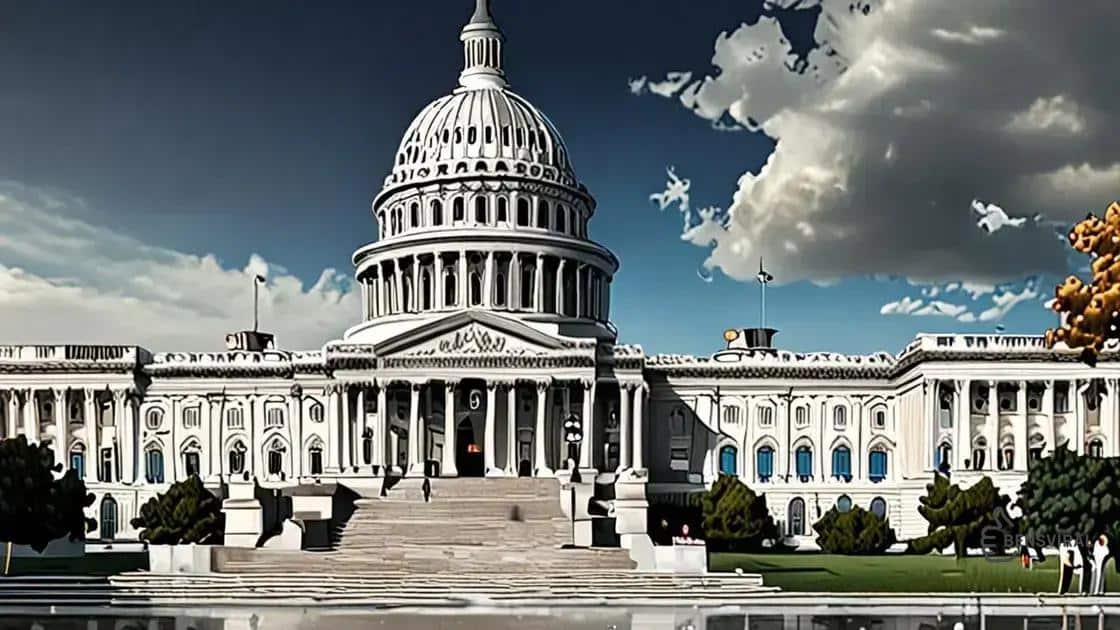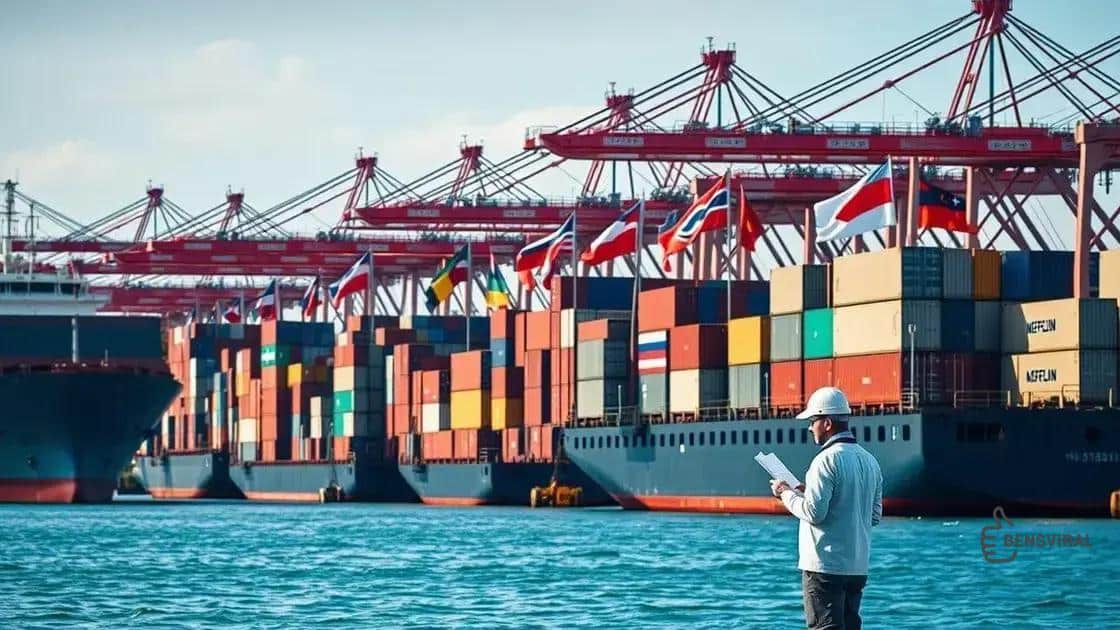Financial policies enacted under the Trump administration

Financial policies enacted under the Trump administration, including tax reforms and trade policies, significantly impacted the U.S. economy by aiming to stimulate growth and job creation while presenting challenges in areas such as income inequality and international relations.
Financial policies enacted under the Trump administration had far-reaching effects on the U.S. economy. Many Americans have likely felt changes in their wallets and job opportunities. Let’s delve into these policies and understand their impacts.
An overview of Trump’s financial policies
Understanding Trump’s financial policies is crucial for grasping his administration’s impact on the economy. These policies aimed to reshape various economic sectors, influencing everything from taxation to trade. Let’s dive into an overview of his key financial initiatives.
Tax Reforms
One of the most significant changes was the introduction of the Tax Cuts and Jobs Act. This legislation lowered corporate tax rates and offered tax relief to individuals. The idea was to spur economic growth. Many supporters claimed it would lead to job creation and higher wages.
Trade Policies
Trump’s administration also focused on reworking trade agreements. With the goal of reducing the trade deficit, he imposed tariffs on a variety of goods, particularly from China. While some industries benefitted from these policies, others argued that they led to increased prices and strains in international relations.
Regulatory Changes
Reducing regulations was another cornerstone of Trump’s financial strategy. By rolling back various rules, the administration aimed to make it easier for businesses to operate. This approach was believed to stimulate investment and boost competitiveness.
Important Impacts
- Increased corporate profits due to lower tax rates.
- Concerns about rising prices for consumers because of tariffs.
- Mixed reviews on the effectiveness of regulatory rollbacks.
- Short-term job growth, with questions about sustainability.
Overall, Trump’s financial policies had significant implications for multiple sectors. While his supporters celebrated the economic boost, critics pointed to growing inequalities. The different approaches taken left many wondering about long-term consequences and the real beneficiaries of these policies.
Tax reforms and their consequences
The tax reforms initiated under the Trump administration had a profound impact on the American economy. The Tax Cuts and Jobs Act, enacted in 2017, was designed to simplify the tax code and reduce tax burdens on various groups.
Key Features of the Tax Cuts
This legislation included significant changes. For instance, the corporate tax rate was cut from 35% to 21%. This move aimed to make U.S. businesses more competitive globally. Additionally, individual tax rates were adjusted, with many Americans seeing a decrease in their tax liabilities.
Effects on Individuals and Businesses
For individuals, these changes resulted in varying outcomes. Some households received higher refunds, while others faced unexpected expenses. On the business side, many corporations reported record profits following these tax cuts. However, the long-term sustainability of these benefits remained a topic of debate.
Positive Outcomes
- Encouraged investment in infrastructure and job creation.
- Provided businesses with more cash flow for expansion.
- Stimulated wage growth in certain sectors.
Despite these positives, there were also challenges. Critics argued that the tax cuts disproportionately favored the wealthy. This created concerns about increasing income inequality. Furthermore, the tax reform led to a sizable increase in the national deficit, raising questions about budgetary implications for future generations.
In summary, while the tax reforms under Trump aimed to boost the economy, they produced mixed results. Understanding these consequences is vital for assessing the overall effectiveness of the policies implemented during his presidency.
Trade policies and economic effects

The trade policies implemented during the Trump administration significantly altered the landscape of international trade. His administration focused on renegotiating existing trade agreements to prioritize American interests. This shift aimed to address trade deficits and protect American jobs.
Tariffs on Imported Goods
One of the most notable aspects of Trump’s trade policy was the imposition of tariffs on imported goods, particularly from China. These tariffs were intended to make foreign products more expensive, encouraging consumers to buy American-made products instead. While some industries thrived under these tariffs, others faced increased costs, which were often passed on to consumers.
Renegotiation of Trade Agreements
Under Trump, the administration renegotiated key trade agreements, including NAFTA, which became the USMCA. This new agreement aimed to benefit American farmers, workers, and businesses more directly. Many viewed this move as a way to reinforce U.S. economic sovereignty in the face of globalization.
Economic Impact
- Increased domestic production in certain industries due to tariffs.
- Higher prices on imported goods affecting consumers.
- Job losses in sectors dependent on global supply chains.
The effects of these trade policies were mixed. While supporters highlighted the benefits to American manufacturers, critics pointed out the negative consequences for consumers and specific industries. For example, agricultural sectors faced retaliatory tariffs from other countries, making it harder for them to export their products. Moreover, the long-term sustainability of such policies remained a topic of discussion among economists.
Overall, the trade policies enacted during the Trump presidency highlighted the complexities of balancing national interests with the realities of a global economy. Understanding these effects provides crucial insights into the ongoing debates about trade in the U.S.
Regulatory changes and their implications
The regulatory changes made during the Trump administration represent a significant shift in how various industries operate. The goal of these changes was to reduce what many viewed as overly burdensome regulations that hindered business growth and innovation.
Key Changes in Regulations
Under Trump, a concerted effort was made to roll back regulations across several sectors, including environmental protections, labor laws, and financial industry oversight. For instance, the administration worked to eliminate the Clean Power Plan, which had aimed to reduce carbon emissions significantly.
Impact on Businesses
Removing regulations often resulted in shorter approval processes for new projects. This was seen as a win for developers and manufacturers, making it easier to launch new initiatives. Yet, while businesses enjoyed greater flexibility, many environmental and safety advocates raised alarms about the potential risks these changes posed to health and the environment.
Economic and Social Implications
- Increased business activities due to fewer regulatory hurdles.
- Concerns over environmental degradation and public health risks.
- Critics worried about compromised worker protections and safety.
The implications of these regulatory changes were both immediate and long-lasting. For example, while businesses reported increased profits and shorter timelines for projects, critics pointed out instances where public safety was at risk. Additionally, reduced oversight in the financial sector sparked debates about the potential for future economic crises.
Overall, the regulatory changes under the Trump administration have sparked significant discussions about the balance between economic growth and the need for regulations to protect the environment and public well-being. Grasping these implications is vital for understanding the broader consequences of his presidency.
The impact on job creation and growth
The impact on job creation and growth during the Trump administration was a key focus of his economic policies. Many believed that his initiatives, such as tax cuts and deregulation, would lead to increased employment opportunities.
Tax Cuts and Job Growth
One of the major strategies was the implementation of the Tax Cuts and Jobs Act. This aimed to stimulate the economy by allowing businesses to invest more in their operations. As a result, some companies expanded their workforces, claiming to create new jobs.
Deregulation Effects
Alongside tax cuts, aggressive deregulation was believed to have a positive effect on job creation. The administration focused on removing regulations that they argued hampered business growth. This included relaxed regulations in industries like manufacturing, which proponents claimed would boost job opportunities.
Challenges to Job Growth
- Many sectors, such as retail, faced challenges due to online competition.
- Job creation varied significantly by region and industry.
- Concerns about job quality and wages arose amid the growth.
However, the actual impact on job creation was mixed. While some industries flourished, others struggled. For instance, the transition towards automation and technology left many workers vulnerable. In the context of overall growth, the unemployment rate did drop, but the benefits of these policies were not evenly distributed across all demographics.
Moreover, the economy faced external challenges, such as global trade tensions that affected various job sectors. These factors make it essential to analyze the full picture of job creation during and after the Trump administration to understand its lasting effects.
FAQ – Frequently Asked Questions about Financial Policies Enacted Under the Trump Administration
What was the main goal of the tax reforms under Trump?
The primary goal of the tax reforms was to stimulate economic growth by reducing tax burdens on individuals and businesses, aiming to create jobs.
How did trade policies affect American jobs?
Trade policies, especially the imposition of tariffs, aimed to protect American jobs but also led to job losses in industries reliant on global supply chains.
What were the effects of deregulation on businesses?
Deregulation aimed to reduce bureaucratic hurdles for businesses, potentially fostering growth, but raised concerns about environmental and worker protections.
Why are the long-term effects of these policies significant?
Understanding the long-term effects is crucial as they influence current economic conditions and can impact future decision-making regarding financial policies.






